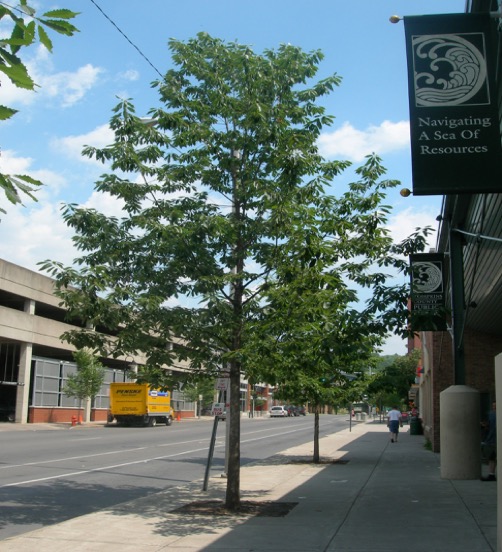With the benefits of trees in urban environments becoming more obvious Dr Nina Bassuk and colleagues discuss selection and implementation
The benefits of trees in urban environments are increasingly being recognised. Looking forward, the ecosystem services provided by the urban forest will be vital to urban communities and will reduce the effects of climate change. They include provisioning services (e.g. fuel), regulating services (e.g. storm water management, urban heat island mitigation, air pollution regulation), cultural services (e.g. recreation, physical and mental health benefits), and supporting services (e.g. wildlife habitats).
Recognition of these benefits has motivated green infrastructure policy makers to implement ambitious tree planting programs, especially in North America. For example, Los Angeles, New York City, Houston, Salt Lake City and Denver have established planting goals of 1 million trees, while Sacramento has a planting goal of 5 million trees. Similar ‘million tree programs’ have been launched in other parts of the world, such as Shanghai. Within such planting programs, it is important to be strategic in the selection of trees so that new plantings can develop into mature trees, as their contribution to ecosystem services is improved with increasing tree size. This requires that species are carefully matched to their planting site environmental conditions and that their vulnerability to pests and pathogens is minimised.

In addition, high species diversity is argued to be the most important requisite for a resilient urban forest. In spite of this, there are many cities in the northern hemisphere that have very limited species diversity within their tree population. Consequently, there is an immense risk to urban canopy cover, if these over-used species succumb to serious pests or pathogens.
Water stress is the main environmental constraint for trees in urban environments and, in many regions, it is likely to increase under future climate scenarios. Therefore, a quantitative indication of tree drought tolerance should always be a fundamental consideration in tree selection for urban environments. In nature, trees have evolved a broad continuum of strategies to cope with warm and periodically dry conditions. These strategies arise from a combination of drought-avoidance and/or drought tolerance traits evolved by different species in response to water deficits of different frequencies and duration. Avoidance of water deficits involves either maximising water acquisition or reducing water use. Species that would naturally avoid water deficits by rooting deeply are often thwarted in urban sites with minimal soil depth and, as a result, perform poorly. Other avoidance strategies, such as when tree close their stomata, (the openings where carbon dioxide is taken for photosynthesis and water vapor is lost) are likely to diminish the ecosystem services delivered by the tree. However, drought tolerance traits allow the tree to maintain physiological functions where there are soil water deficits. Traits that confer tolerance of water deficits have inherent interest to those selecting trees as they allow the tree to maintain leaf gas exchange, hydraulic conductance and growth for longer during a dry period. Leaf water potential at turgor loss provides a robust measure of plant drought tolerance, as a more negative water potential allows the leaf to maintain physiological function even under soil water deficits. Therefore, measuring tree water potentials at turgor loss point is a trait that provides information about a species´ capacity to grow in dry environments and is particularly relevant for paved urban sites, characterised by restricted soil volumes and impermeable surfaces).
Current tree stress tolerance is predominantly based on the authors’ own experiences and qualitative observations from arboreta, botanical gardens and other tree collections. Such guidance is acquired over decades of observation in the field. By definition these observations are variable and do not encompass non-traditional tree species that may be successful in the urban environment. A simple measurement of tree turgor loss can provide a rapid quantification of a trees’ fitness to grow well in urban environments while simultaneously increasing species diversity.
Authors:
Henrik Sjoman Faculty of Landscape Planning, Horticulture and Agricultural Science, Department of Landscape Architecture, Planning and Management, Swedish University of Agricultural Sciences, PO-Box66, SE-23053 Alnarp, Sweden
Andrew Hirons University Centre Myerscough, Bilsborrow, Preston, Lancashire PR30RY, UK
Nina Bassuk Urban Horticulture Institute, School of Integrative Plant Science, Cornell University, Ithaca, NY 14853-5904, USA








